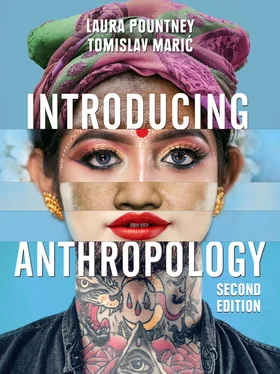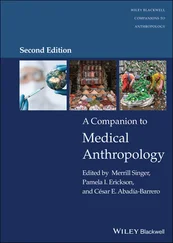In 2019, the AAPA issued another statement that aimed to clarify and update the AAA’s statement. Here is an extract from this statement:
Race does not provide an accurate representation of human biological variation. … Humans are not divided biologically into distinct continental types or racial genetic clusters. Instead, the Western concept of race must be understood as a classification system that emerged from, and in support of, European colonialism, oppression, and discrimination. … Because of that, over the last five centuries, race has become a social reality that structures societies and how we experience the world. In this regard, race is real, as is racism, and both have real biological consequences .
STOP & THINK
How are the 1988 AAA Statement on Race and the 2019 AAPA Statement on Race and Racism trying to ‘decolonize’ anthropology?
It is possible to see that what makes us human are evolved biological characteristics that in many complex ways link to culturally evolved behaviours. Anthropologists have different views on the extent of the relationship between human biology and culture. One major key to the survival of human beings is their ability to adapt to their environment. This has been crucially important, given the major changes that have occurred in the environment at critical stages over the course of human evolution.
There are minor biological differences between human groups. Biological anthropologists are interested in these differences in terms of genetic ancestry, particularly in relation to how other groups of early humans overlapped. Cultural anthropologists, however, are interested in the ways that perceived differences between groups of people are misused by some for economic and political reasons.
The relationship between human biology and human culture is only one of the many problems addressed by evolutionary anthropology. Understanding the processes behind the origin of humankind and the evolution of our unique adaptations are among the most fundamental questions that we have asked ourselves. The search for answers places the study of human evolution at the heart of anthropology.
Do primates have language/culture? If so, how is this the same or different from human language/culture?
What are main differences between chimpanzees and bonobos? How can we apply those findings to the study of human beings and their behaviours?
How has DNA analysis changed the way anthropologists understand human evolution?
Race is no longer a useful category. Discuss.
altruismThe ability to put the needs of others before your own
AnthropoceneA new planetary era in which humans have become the dominant force in shaping the earth’s physical make-up and processes
bipedalismWalking upright on two feet for the majority of time
catastrophismThe theory that the Earth has been affected in the past by sudden, short-lived, violent events, possibly worldwide in scope, which have led to the contemporary world with its current variety of animals and plants
creationismThe belief that all life was created by the actions of God
cultural evolutionThe ways in which humans have evolved beyond their biology
culturally constructedSomething which is created by society
endemic dwarfismA process whereby some creatures confined to isolated habitats such as islands are known to have become smaller
EnlightenmentA period in Europe during the eighteenth century when there were many scientific discoveries that contradicted the accepted teachings of those in authority, notably the Church
evolutionAny change across successive generations in the inherited characteristics of biological populations
fossilThe preserved remains or traces of animals, plants and other organisms from the remote past
homininsPrimates, species who are closely related to human beings or who are regarded as human
hunter-gatherersMembers of a nomadic people who live chiefly by hunting and fishing and harvesting wild food
intelligent designAlso known as neo-creationism, the belief that the current state of life on Earth has come about through the actions of an intelligent designer; this designer need not be God, but most proponents of intelligent design seem to have God in mind
mammalAny warm-blooded vertebrate animal, including humans, characterized by a covering of hair on the skin and, in the female, milk-producing mammary glands for feeding the young
natural selectionThe process in nature by which, according to Darwin’s theory of evolution, only the organisms best adapted to their environment tend to survive and transmit their genetic characteristics in increasing numbers to succeeding generations, while those less well adapted tend to be eliminated
omnivorousAbility to eat and survive on both plant and animal matter
opposable thumbA thumb that is sufficiently separate from the other fingers of the hand to allow for precision grip
paleoanthropologyThe study of extinct early primates and fossil remains of early primates
paleontologyThe study of life on earth, often drawing on information provided by fossils
primateA mammal of the order Primates, characterized, for example, by refined development of the hands and feet and a large brain
racismDiscrimination against an individual or group based on their perceived ethnicity and the idea that ‘race’ is a fixed and bounded reality
sexual dimorphismThis refers to both the internal and the external differences between males and females found in a variety of animals and plants
sociobiologyAn area of biology that aims to explain social behaviour in terms of evolution
symbolSomething that is used to represent an idea or object
taxonomyThe classification of organisms in an ordered system that indicates natural relationships
Visit your local zoo, or the internet, and investigate the bonobos and chimpanzees. Consider the ways in which humans share biological attributes and discuss the impact of this on the behaviour of the primates. Consider the ways in which the primates relate to one another and how they use their space and arrange social relations. Explore and investigate the extent to which captivity affects their behaviour. Make notes on any cultural characteristics you see – for example, in terms of hierarchy. Draw up a detailed report on your findings.
Suggested further sources
Books
Barnard, A. (2011) Social Anthropology and Human Origins . Cambridge University Press.
Kuper, A. (1994) The Chosen Primate: Human Nature and Cultural Diversity . Harvard University Press.
Lieberman, D. (2014) The Story of the Human Body: Evolution, Health and Disease . Penguin.
Mithen, S. (2005) The Singing Neanderthals: The Origins of Music, Language, Mind and Body . Phoenix Press.
Roberts, A. (2017) Tamed: 10 Species That Changed Our World . Hutchinson Press.
Rutherford, A. (2017) A Brief History of Everyone Who Ever Lived: The Stories in Our Genes . W&N Press.
Wrangham, R. (2009) Catching Fire: How Cooking Made Us Human . Profile Books.
Читать дальше












